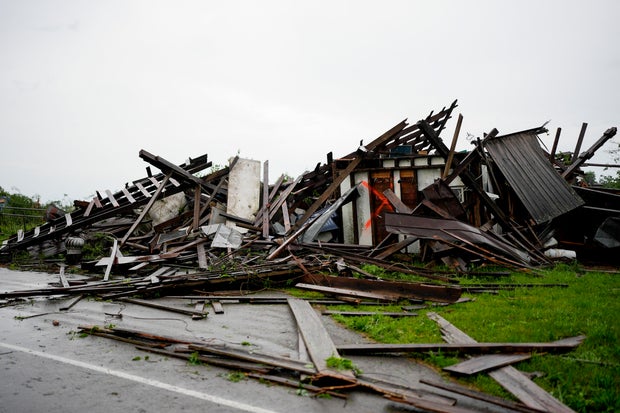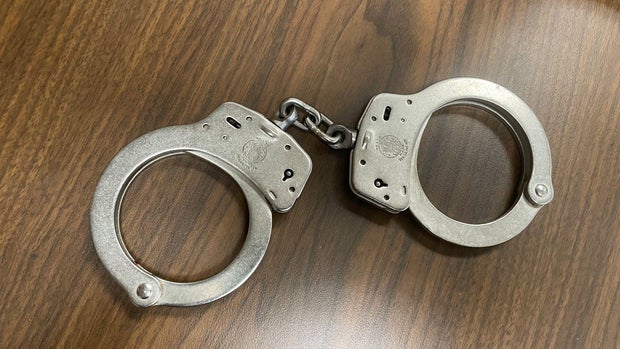CBS News
Powerful storms slam parts of Florida, North Carolina, other states as cleanup from earlier tornadoes continues

Powerful storms with damaging high winds threatened several states in the Southeast early Friday, as residents elsewhere in the U.S. cleared debris from deadly severe weather that produced twisters in Michigan, Tennessee and other states.
Storms rolled into Tallahassee, Florida, where numerous trees were toppled around the state’s capital city, authorities said Friday. Wind gusts of 71 mph were recorded by a weather station near the State Capitol Complex, the National Weather Service reported. Florida State University announced its campuses in Tallahassee were closed Friday due to the severe weather. Nonessential personnel, students and visitors should avoid campuses in Tallahassee until further notice, the school said in a social media post.
The city of Tallahassee said on social media platform X that “possible tornadic activity” caused the widespread damage in the Florida capital, especially to electric lines and numerous downed trees. The city said more than 66,000 customers are without electric service, and 11 substations were damaged by the storm.
“Restoration will possibly take through the weekend,” the announcement said.
Phil Sears / AP
Strong thunderstorms also were expected in Alabama near the Florida panhandle, where gusty winds could knock down tree limbs, the weather service said.
In Mississippi’s capital city of Jackson, authorities on Friday were asking residents to conserve water after a power outage at one of its major water treatment plants. JXN Water, the local water utility, said in a statement that customers can expect reduced water pressure as workers assess damages due to storms that rolled through the region overnight. The weather service said Hickory Hills and surrounding areas near the coast were likely to get severe weather Friday morning, and that hail with the potential to damage vehicles was expected.
More than 320,000 homes and businesses across the South, from Mississippi to North Carolina, were without electricity Friday morning, according to the website poweroutage.us. Most of those outages were in Florida, where lights and air conditioning were out for more than 180,000 customers.
Several tornado warnings and watches were issued by the National Weather Service on Friday morning, but were lifted by midday as the threat shifted to damaging high winds. Since Monday, 39 states have been under threat of severe weather and at least four people have died. On Wednesday and Thursday, about 220 million people were under some sort of severe weather risk, said Matthew Elliott, a Storm Prediction Center forecaster.
Fatalities, injuries after severe weather’s destructive path
A storm was blamed for killing a 22-year-old man in a car in Claiborne County, north of Knoxville, officials said. A second person was killed south of Nashville in Columbia, the seat of Maury County, where officials said a tornado with 140 mph winds damaged or destroyed more than 100 homes.
Tennessee Gov. Bill Lee said the woman who died in Maury County was in a mobile home that was thrown several feet into a wooded area. Lee visited emergency managers and Tennessee Department of Transportation officials in the storm-stricken area Thursday.
Torrential rains led to a flash flood emergency and water rescues northeast of Nashville, and the weather service issued a tornado emergency, its highest alert level, for nearby areas.
A 10-year-old boy was seriously injured in Christiana, southeast of Nashville, when he got caught in a storm drain and swept under streets while playing with other children as adults cleared debris, his father, Rutherford County Schools Superintendent Jimmy Sullivan, posted on social media.
George Walker IV / AP
The boy, Asher, emerged in a drainage ditch and survived after being given CPR, “but the damage is substantial,” Sullivan posted on Facebook, asking for prayers.
“Asher needs a miracle,” Sullivan wrote.
Dozens of people gathered at the school district’s offices for a prayer vigil Thursday. They bowed their heads and closed their eyes in prayer, and they sang “Amazing Grace” together.
Schools were closed Thursday and Friday in Rutherford and Maury. In Georgia, some districts north of Atlanta canceled in-person classes or delayed start times because of storm damage overnight that included fallen trees on houses and vehicles around Clarkesville. No injuries were reported there.
Both the Plains and Midwest have been hammered by tornadoes this spring.
CBS News
Mountain Fire has now burned over 20,000 acres north of Los Angeles

Watch CBS News
Be the first to know
Get browser notifications for breaking news, live events, and exclusive reporting.
CBS News
Police-style handcuffs on Texas murder victim made investigators fear the killer was among them

On Jan. 14, 1995, Mary Catherine Edwards, 31, a beloved elementary school teacher, was found dead in her townhouse in Beaumont, Texas.
Her parents found her. It was a terrible scene: she was in her bathtub, handcuffed, and had been sexually assaulted. There were no signs of forced entry, which made investigators think she must know her killer. The police-grade Smith & Wesson handcuffs were always a big clue, but when detectives tried tracing the serial numbers, they came up empty. Early investigators questioned various law enforcement officers and came up with nothing either.
Texas Department of Public Safety
The case went cold, but as Beaumont police Det. Aaron Lewallen told “48 Hours” contributor Natalie Morales, “It was almost talked about like a ghost story around a campfire. Could it have been somebody that we knew?” Morales reports on the search for answers in “Tracking the Killer of Mary Catherine Edwards,” airing Saturday, Nov. 9 at 10/9c on CBS and streaming on Paramount +.
Thanks to carefully preserved DNA from the crime scene and the advent of genetic genealogy, Det. Aaron Lewallen, his wife Tina Lewallen, also a detective — along with Brandon Bess, a Texas Ranger in the cold case division, and Shera LaPoint, a professional genealogist — spent almost three months working together in a nonstop push to finally solve the case.
After all the early leads and the suspicion that someone in law enforcement had been involved, the family tree they constructed revealed someone else. Their chief suspect turned out to be not a law enforcement officer, but a man who went to the same high school as Edwards: Clayton Foreman.
And then they learned that Edwards and her identical twin sister Allison had been bridesmaids in Foreman’s first wedding. The sisters were good friends with his first wife, Dianna Coe, who also went to the same high school.
Coe remembers them fondly, telling Morales how kind they were to her when she moved to a new town and started a new school.
“I was new to the area … so, I knew no one. And they … just started talking to me and asked me my name … and we were friends from that point forward,” Coe said.
The sisters were the first people Coe thought of to be bridesmaids at her wedding. She and Foreman stayed married for 11 years. They were divorced by the time of the murder, but in hindsight, Coe began to see things in a different, darker, light. She remembered her ex-husband’s fascination with the police officers and their tools of the trade, like handcuffs and billy clubs. As Coe told Morales, “He had a billy club that he kept…by the bed. You know, said it was for protection. And I remember that he had ordered those handcuffs…Well, he had them hung over the rearview mirror.”
Coe also remembered a disturbing conversation with her ex-husband when she heard Edwards had been murdered and called to talk about it.
“I think I was, you know, crying and I said, ‘oh, my God,’ I said, ‘somebody has murdered Catherine,” Coe told “48 Hours.” “And — and he goes, ‘Oh, really?’ Just like no emotion, which I thought that was odd.”
Texas Department of Public Safety
A DNA match quickly established that Foreman had indeed been at the crime scene. And when Det. Aaron Lewallen and Ranger Bess went to question Foreman, they had an arrest warrant. They also brought something with them — something very symbolic.
Together, they had taken the time to work out an arrangement with the prosecutors so they could use the handcuffs taken as evidence at the crime scene. When they arrested Foreman for the murder of Edwards, they did so with the very handcuffs that had bound her the night she died. He wasn’t one of them, but in the course of the investigation, they learned Foreman had been falsely claiming to be a police officer.
The handcuffs — such a focus in the beginning — came full circle at the end. Bess will never forget how it felt. As he told Morales, “It’s a moment I’ll never forget…you feel like you got to do something for Catherine there…You know, like physically got to do for her, is take those cuffs that bound her when she was murdered and put them back on the guy that murdered her…It may seem small to some, but it was a really big deal to us, and it felt good.”
The jury in Foreman’s murder trial deliberated for less than an hour before finding him guilty of the murder of Edwards. Foreman was sentenced to life in prison.
CBS News
What to know about Susie Wiles, Trump’s new chief of staff

Watch CBS News
Be the first to know
Get browser notifications for breaking news, live events, and exclusive reporting.











